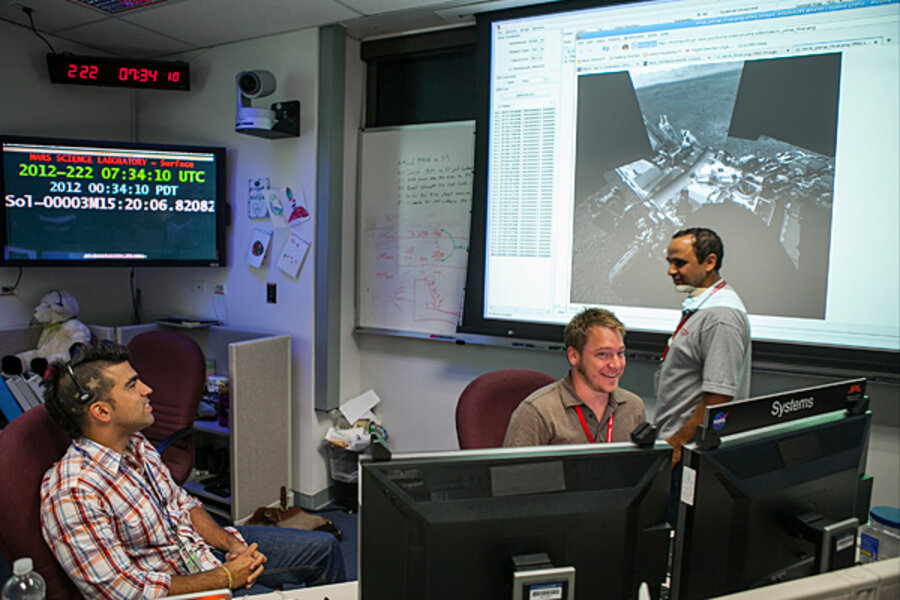'We're NASA and We Know It' video spoofs JPL Mars team. How cool is that?
Loading...
The folks at JPL have arrived. No, not just because the NASA center's best and brightest put the Mars rover Curiosity flawlessly on the surface of the Red Planet. But because they looked so cool doing it. So cool, in fact, that there is now a rap video on youtube lampooning their performance: "We're NASA and We Know It."
The video is a tongue-in-cheek high-five to the group in pale-blue polo shirts who sat in mission control on a southern California foothill the evening of Aug. 5, watching as helplessly as the rest of the world as Curiosity entered its final "seven minutes of terror" en route to the surface of Mars.
The slickly produced video features what looks to be seven 20-somethings – including a bikini-clad woman with a box over her head. If there's any message in there at all, it might be something like: If you want to do some really cool stuff in space, and you've got the smarts, and you don't want to wait until you're about to collect Social Security to play a key role, then Jet Propulsion Laboratory is the place to be.
OK, a bit overstated, but look at the mix of faces in that control room – the real one, not the cute video version – or the hair styles. When was the last time you saw a red-and-blue-tinted Mohawk hairstyle poking above a console in Houston? Or the official pass-around of the peanut jars to mark the end of a key part of a mission? And where else within the NASA network would a set of wheels be designed to leave a research center's initials – in Morse Code – in the dust as a rover rolls along the surface of another planet?
Yes, spaceflight is risky. And it uses very expensive hardware. But somehow the folks at JPL have managed to find ways to blend the discipline and focus required for space exploration with creativity and whimsy. At best, it leads to a unique twist on landing a craft on Mars. At a minimum, it can break the tension that builds after long hours of worrying about unknowns as a team strives to meet a launch opportunity that comes around but once every 26 months.
And when the Big Event approaches, which center is going to produce a slick, sweaty-palms video to prepare the public for Curiosity's seven minutes of terror? Or cook up a deal with Microsoft to develop an Xbox game that allows the player, using a generous amount of body English, to guide the rover through those seven minutes – and with additional, more-involved video games under consideration? Yep, that's JPL.
What accounts for the difference between JPL and NASA's other centers?
Gentry Lee, the center's chief engineer for solar system exploration, sums it up:
"We are part of CalTech. We are not under civil-service restrictions. We are allowed to think outside the box," he says. "That has a huge impact on the way we do things."
With such tight ties to the California Institute of Technology, which has had its share of creative, if sometimes quirky geniuses, thinking outside the box is built into JPL's intellectual DNA.
Take CalTech astronomer Franz Zwiky, a top astrophysicist of the 20th century. He once ordered an assistant to fire a rifle into the air to remove the atmospheric turbulence during a night at the telescope (it didn't work). But his homemade ski-jump ramp near the observatory worked like a charm.
And for those touched by the loss of the space shuttle Challenger and its seven-member crew, who could forget the Nobel-prize winning physicist and frequent bongo player Richard Feynman? He became the instant star of the Rogers Commission investigation into the accident when he dipped a now-infamous rubber O-ring into a glass of ice water, in one simple act demonstrating the cause of the accident that destroyed one-fourth of the shuttle fleet.
In the 1960s and '70s, NASA east of the Rockies was awash with crew-cut men in white shirts and narrow ties. JPL, on the other hand? Here's how Mr. Lee tells it:
"If you go back to the days of Viking and you see a photograph of me, my hair is down to my shoulders in curls and I'm wearing white pants with strawberries scattered all over them," says Lee, who was deeply involved in the Viking mission, first at Martin Marietta – which built the landers, their descent stages, and the rockets that launched them – and later at JPL.
"The reason that is true," he continues, "is that throughout the planetary exploration program in particular, the emphasis has been on substance, not appearance.
"The best and the brightest of the engineers want to go do something that's never been done before, and that they are not even sure they can do," he says.
Those are the young folks coming out of grad schools whom JPL strives to snag.
As for the seven minutes of terror video and the Xbox game?
Those "were done on purpose," he says – efforts to capitalize on a historic mission, one that hopes to see if Mars ever could have hosted life, in hopes of galvanizing public support for a planetary exploration program that is on the fiscal ropes.
"The United States, and JPL in particular, began the exploration of the solar system," Lee says.
Yet next year's budget, which takes effect Oct. 1, cuts the planetary science budget for NASA by 20 percent, and the Mars program in particular by nearly 40 percent.
The danger, Lee says, is "we are about to become the Portuguese of the 21st Century. Under Henry the Navigator, they began exploring the world, but then they pulled back."
They lost their sense of vision, he says.







